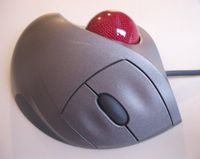|
|
|
Tracker Ball |
||||
A trackball is a pointing device consisting of a ball housed in a socket containing sensors to detect rotation of the ball about two axes—like an upside-down mouse with an exposed protruding ball. The user rolls the ball with the thumb , fingers , or the palm of the hand to move a cursor . Large tracker balls are common on CAD workstations for easy precision. Before the advent of the touchpad , small trackballs were common on portable computers , where there may be no desk space on which to run a mouse. Some small thumbballs clip onto the side of the keyboard and have integral buttons with the same function as mouse buttons. When mice and trackballs still had chopper wheels, trackballs had the advantage of being in contact with the user's hand, which is generally cleaner than the desk or mousepad and doesn't drag lint into the chopper wheels. The late 1990s advent of scroll wheels , and the replacement of mouseballs by direct optical tracking, put trackballs at a disadvantage and forced them to retreat into niches where their distinctive merits remained important. Most trackballs now have direct optical tracking which follows dots on the ball. Some mice, in place of a scroll wheel, acquired a small trackball between the ears, useful in maps, and other circumstances calling for scrolling in two dimensions.Advantages: • Easy precision. • It has the advantage of being in contact with the user's hand, which is generally cleaner than the desk or mousepad and doesn't drag lint into the chopper wheels. • Some mice, in place of a scroll wheel, acquired a small trackball between the ears, useful in maps, and other circumstances calling for scrolling in two dimensions. Disadvantages: • The late 1990s advent of scroll wheels , and the replacement of mouseballs by direct optical tracking, put trackballs at a disadvantage and forced them to retreat into niches where their distinctive merits remained important. |
||||
 |
||||
| Home | ||||
Inés Imperatrice and Sofía Nicolini |
||||